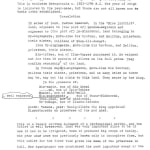Old Babylonian Terracotta Cuneiform Tablet, 1817 BCE - 1794 BCE
Terracotta
2.12 x 3.62
LO.1248
This has a total of 37 lines of Sumerian cuneiform on obverse and reverse and cylinder seal impressions on upper, lower and left edges. It is dated to the reign...
This has a total of 37 lines of Sumerian cuneiform on obverse and reverse and cylinder seal impressions on upper, lower and left edges. It is dated to the reign of Damiq-ilishu, king of Isin in southern Mesopotamia c. 1817 – 1794 B.C. The year of reign is indicated by the year-name, but these are not all known nor is their order establishe
Translation:
10 acres of land, rushes removed, in the “Nice District” land, adjacent to (the plot of) Mannum-mahirshu and adjacent to (the plot of) Lu-Ninshubur, land belonging to Ur-nigingarra, Mutu-ilum his brother, and Belitum, priestess, their sister, children of Shep-ili-damqat:
from Ur-nigingarra, Mutu-ilum his brother, and Belitum, priestess, their sister,
Sin-iribam, son of Ilum-tayyar purchased it. He weighed out for them 18 shekels of silver as its full price. The confirm ownership(?) of the land.
In future days Ur-nigingarra, Mutu-ilum his brother, Belitum their sister, priestess, and as many heirs as there may be, may not lay claim to this land. They swore by the king.
In the presence of:
Sin-magir, son of Sin Shem …..mu, son of Ipiq-Ishta Humusi, son of Nabi-Enli Sin-mushtesher, seal engraver, son of Puzur-Ninkarrak, Ibbi-Adad, son of Adad-rabi,
Ur-Dukugam son of Ilushu-ibbish
Month: Tammuz, year: Damiq-ilishu the king appointed Ninshatapadda as priestess of the god Adad.
This is a nicely written document of a professional scribe, and the tablet is well preserved. Land was very important since to be of use it had to irrigated, then it produced big crops of barley. The year name here was previously known only in incomplete form, but this tablet for the first time gives the name of the priestess in full. Her appointment was considered the most important event of the year.
Seals showing: Ur-nigingarra Belitu Son of Shep-ili-damqat daughter of Shep-ili-damqa Mutu-ilum son of Shep-ili-damqat
Description and translation kindly provided by Professor W. G. Lamber
Translation:
10 acres of land, rushes removed, in the “Nice District” land, adjacent to (the plot of) Mannum-mahirshu and adjacent to (the plot of) Lu-Ninshubur, land belonging to Ur-nigingarra, Mutu-ilum his brother, and Belitum, priestess, their sister, children of Shep-ili-damqat:
from Ur-nigingarra, Mutu-ilum his brother, and Belitum, priestess, their sister,
Sin-iribam, son of Ilum-tayyar purchased it. He weighed out for them 18 shekels of silver as its full price. The confirm ownership(?) of the land.
In future days Ur-nigingarra, Mutu-ilum his brother, Belitum their sister, priestess, and as many heirs as there may be, may not lay claim to this land. They swore by the king.
In the presence of:
Sin-magir, son of Sin Shem …..mu, son of Ipiq-Ishta Humusi, son of Nabi-Enli Sin-mushtesher, seal engraver, son of Puzur-Ninkarrak, Ibbi-Adad, son of Adad-rabi,
Ur-Dukugam son of Ilushu-ibbish
Month: Tammuz, year: Damiq-ilishu the king appointed Ninshatapadda as priestess of the god Adad.
This is a nicely written document of a professional scribe, and the tablet is well preserved. Land was very important since to be of use it had to irrigated, then it produced big crops of barley. The year name here was previously known only in incomplete form, but this tablet for the first time gives the name of the priestess in full. Her appointment was considered the most important event of the year.
Seals showing: Ur-nigingarra Belitu Son of Shep-ili-damqat daughter of Shep-ili-damqa Mutu-ilum son of Shep-ili-damqat
Description and translation kindly provided by Professor W. G. Lamber



